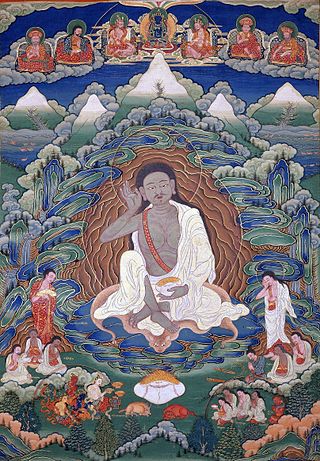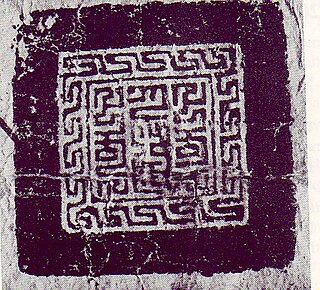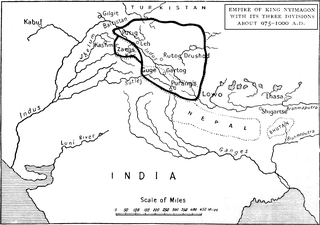
While the Tibetan plateau has been inhabited since pre-historic times, most of Tibet's history went unrecorded until the introduction of Tibetan Buddhism around the 6th century. Tibetan texts refer to the kingdom of Zhangzhung as the precursor of later Tibetan kingdoms and the originators of the Bon religion. While mythical accounts of early rulers of the Yarlung Dynasty exist, historical accounts begin with the introduction of Buddhism from Nepal in the 6th century and the appearance of envoys from the unified Tibetan Empire in the 7th century. Following the dissolution of the empire and a period of fragmentation in the 9th-10th centuries, a Buddhist revival in the 10th–12th centuries saw the development of three of the four major schools of Tibetan Buddhism.

Amdo is one of the three traditional Tibetan regions, the others being U-Tsang in the west and Kham in the east. Ngari in the north-west was incorporated into Ü-Tsang. Amdo is also the birthplace of the 14th Dalai Lama. Amdo encompasses a large area from the Machu to the Drichu (Yangtze). Amdo is mostly coterminous with China's present-day Qinghai province, but also includes small portions of Sichuan and Gansu provinces.

Guge was an ancient dynastic kingdom in Western Tibet. The kingdom was centered in present-day Zanda County, Ngari Prefecture, Tibet Autonomous Region. At various points in history after the 10th century AD, the kingdom held sway over a vast area including south-eastern Zanskar, upper Kinnaur district, and Spiti Valley, either by conquest or as tributaries. The ruins of the former capital of the Guge kingdom are located at Tsaparang in the Sutlej valley, not far from Mount Kailash and 1,200 miles (1,900 km) west from Lhasa.

Rudok, also spelt Rutok and Rutog, more properly Rudok Dzong, is a town that served as the historical capital of the Rudok area in Western Tibet on the frontier with Ladakh. In the 1911 Encyclopædia Britannica, it is described as being "picturesquely situated" on the side of a hill standing isolated in the plain near the east end of Lake Pangong.

Shey is a village in the Leh district of Ladakh, India. It is located in the Leh tehsil, 15 km from Leh towards Hemis. Shey was founded as the summer capital of Ladakh, by the king Lhachen Palgyigon in the 10th century, with Leh being winter capital. It was gradually eclipsed by Leh around the 17th century after the growth of Central Asian trade.

In Tibetan Buddhism and Bon, a ngakpa (male), or a ngakma (female) is any practitioner of Vajrayana who is not a monk or a nun. The terms translates to "man or woman of mantra" or "man or woman of secret mantra". They are often referred to as "householder yogis" or "yoginis" because they maintain a householder lifestyle while engaging in advanced tantric practices.
Darma U Dum Tsen, better known as Langdarma was the 42nd and last king of the Tibetan Empire who in 838 killed his brother, King Ralpachen, then reigned from 841 to 842 CE before he himself was assassinated. His reign led to the dissolution of the Tibetan Empire, which had extended beyond the Tibetan Plateau to include the Silk Roads with the Tibetan imperial manuscript center at Sachu (Dunhuang), and neighbouring regions in China, East Turkestan, Afghanistan, and India.

The Tibetan Empire was an empire centered on the Tibetan Plateau, formed as a result of imperial expansion under the Yarlung dynasty heralded by its 33rd king, Songtsen Gampo, in the 7th century. The empire further expanded under the 38th king, Trisong Detsen, and expanded to its greatest extent under the 41st king, Rapalchen, whose 821–823 treaty was concluded between the Tibetan Empire and the Tang dynasty. This treaty, carved into the Jokhang Pillar, delineated Tibet as being in possession of an area larger than the Tibetan Plateau, stretching east to Chang'an, west beyond modern Afghanistan, and south into modern India and the Bay of Bengal.

Tsaparang was the capital of the ancient kingdom of Guge in the Garuda Valley, through which the upper Sutlej River flows, in Ngari Prefecture near the border of Ladakh. It is 278 km south-southwest of Senggezangbo Town and 26 km west of the 11th-century monastery at Tholing, and not far west of Mount Kailash and Lake Manasarovar. The Tsaparang Dzong was located here. Nearby is the Bon monastery of Gurugem.

Lhachen Palgyigon was the founding king of the Kingdom of Maryul, based in modern Ladakh.
Maryul, also called mar-yul of mnga'-ris, was the western most Tibetan kingdom based in modern-day Ladakh and some parts of Tibet. The kingdom had its capital at Shey.

Purang-Guge kingdom was a small Western Himalayan kingdom which was founded and flourished in the 10th century in western Tibet.
Lingtsang was formerly one of the Kham region's five independent kingdoms of Tibet. The realm of Lingstang was incorporated into the People's Republic of China in 1950 following the Battle of Chamdo.
Buddhists, predominantly from India, first actively disseminated their practices in Tibet from the 6th to the 9th centuries CE. During the Era of Fragmentation, Buddhism waned in Tibet, only to rise again in the 11th century. With the Mongol invasion of Tibet and the establishment of the Mongol Yuan dynasty (1271–1368) in China, Tibetan Buddhism spread beyond Tibet to Mongolia and China. From the 14th to the 20th centuries, Tibetan Buddhism was patronized by the Chinese Ming dynasty (1368–1644) and the Manchurian Qing dynasty (1644–1912) which ruled China.

Polhané Sönam Topgyé was one of the most important political personalities of Tibet in the first half of the 18th century. Between 1728 and 1747 he was effectively the ruling prince of Tibet and carried royal titles during the period of Qing rule of Tibet. He is known as an excellent administrator, a fearsome warrior and a grand strategist. After the troubled years under the reign of Lhazang Khan, the bloody invasion of Tsering Dhondup and the civil war, his government ushered in a relatively long period of stability and internal and external peace for Tibet.

Khangchenné Sonam Gyalpo was the first important representative of the noble house Gashi in Tibet. Between 1721 and 1727 he led the Tibetan cabinet that governed the country during the period of Qing rule of Tibet. He was eventually murdered by his peers in the cabinet, which triggered a bloody but brief civil war. The nobleman Polhané Sönam Topgyé came out as the victor and became the new ruling prince of Tibet under the Chinese protectorate.
We Gyaltore Taknye, also known as Wa Taknachen, was the last Lönchen of the Tibetan Empire. In Chinese records, his name was given as Jié Dūnà.
The Ladakh Chronicles, or La-dvags-rgyal-rabs, is a historical work that covers the history of Ladakh from the beginnings of the first Tibetan dynasty of Ladakh until the end of the Namgyal dynasty. The chronicles were compiled by the Namgyal dynasty, mostly during the 17th century, and are considered the primary written source for Ladakhi history.

Kyide Nyimagon, whose original name was Khri-skyid-lding, was a member of the Yarlung dynasty of Tibet and a descendant of emperor Langdarma. He migrated to Western Tibet and founded the kingdom of Ngari Khorsum around 912 CE. After his death, his large kingdom was divided among his three sons, giving rise to the three kingdoms of Maryul (Ladakh), Guge-Purang and Zanskar-Spiti.
Tashigang (Tibetan: བཀྲ་ཤིས་སྒང་, Wylie: bkra shis sgang, THL: tra shi gang, transl. "auspicious hillock"), with a Chinese spelling Zhaxigang , is a village in the Gar County of the Ngari Prefecture, Tibet. The village forms the central district of the Zhaxigang Township. It houses an ancient monastery dating to the 11th century.















